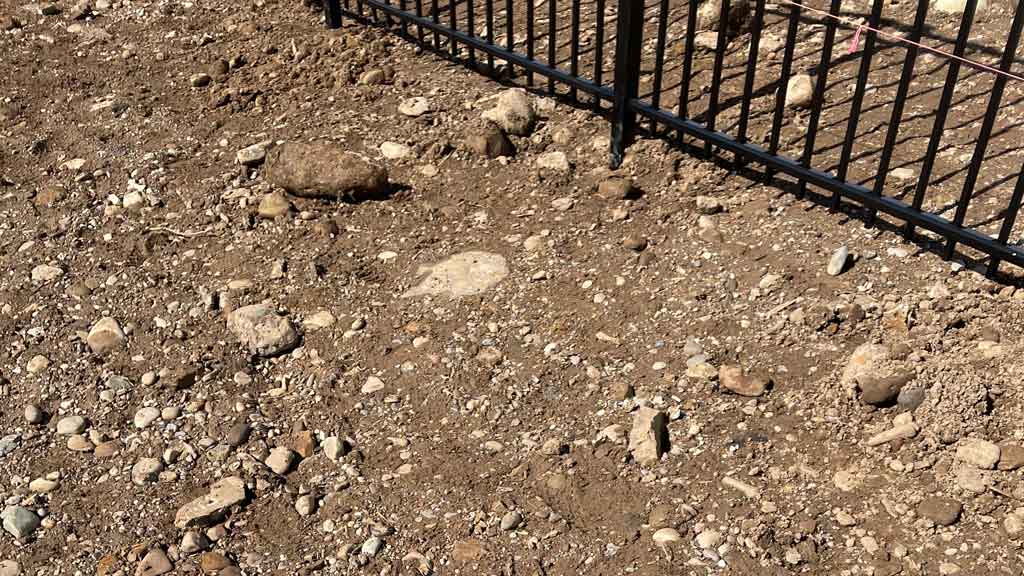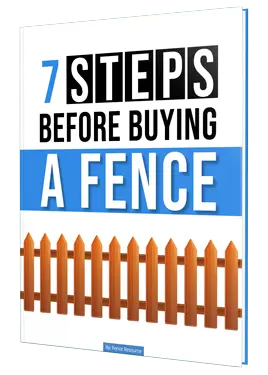Digging fence post holes is hard work. Digging in rocky or rooty ground is much harder. The size of the rocks or roots can make setting posts seem impossible. Not to mention trying to keep your posts spacing on center.
Even when using an auger to dig fence post holes, if the ground has rocks or roots, there will be hand digging involved. As a result, production slows down. Installation takes longer. And worst of all, the labor required for digging holes increases.
However, you can do it. Having the right tools for the job helps. A little help from your friends helps too!
In this article I’ll discuss the challenges of digging holes for fence posts in ground with rocks or tree roots. We’ll talk about tools to make the job easier. Then we’ll discuss how different types of fence installations are effected when digging post holes with rocks and roots.
Digging Fence Post Holes in Rocky Ground

There is nothing worse than digging fence post holes in rocky ground. When using an auger, the rocks cause it to rattle and vibrate violently. Enough to rattle your bones. Furthermore, it is very abusive to the auger. With a high potential for breakdowns.
The size of the rocks matter. Smaller rocks will pass through the flutes of the auger bit. Larger rocks will cause the auger bit to jam in the hole. As a result, the auger bit gates stuck.
The soil type is also a factor. Loose and sandy soils allow rocks to move out of place easier than dense clay type soils. Therefore, the amount of extra labor required to dig holes for a fence in rocky ground is job specific.
When digging using a hand post hole digger, rocky ground prevents hand diggers from getting good bites. Therefore, making the process slower. Large rocks will have to be pried loose from the hole. In worse case scenarios breaking the rocks into smaller pieces is required before extraction.
Helpful Tools for Digging in Rocky Ground
Post Hole Diggers – Use a post hole digger for cleaning loose dirt spoils from holes dug with an auger. Furthermore, they are a necessity for digging in rocky ground. The ability to pick out rocks with a post hole digger instead of by hand saves time. When an auger won’t work, it’s time for post hole diggers.
Spud Bar – A spud bar or digging bar is a long metal pole with a chisel on one end and a flat disc on the other. It resembles a giant nail. It is very heavy. Great for chipping away at hard ground, prying rocks out of holes, or breaking large rocks.
Hammer Drill – A hammer drill is a type of drill that not only spins, but also jack hammers. A selection switch allows it to spin only, hammer and spin or just hammer. Hammer mode with a chisel bit will break through small rocks.
Jackhammer – For larger rocks, a jackhammer comes in handy. Most rental stores will have electric ones for rent. Jackhammers don’t fit into post holes well. Therefore, making the hole larger is require to fit one.
Digging Fence Post Holes Around Tree Roots

Digging fence post holes in tree roots isn’t easy. However, it is easier than digging holes in rocky ground. Most times, after you pass through the first root, the digging gets easier. Although, sometimes roots stacked on top of roots still make digging difficult.
The size of the root matters. Most times an auger will chew through smaller roots. Larger roots will take some effort to get through. For the largest roots, it is better to bypass them. This also avoids causing any damage to the tree.
The type of tree root also effects how hard the digging is. Soft root systems like those of a pine tree are easy to cut through. Even when the auger won’t pass through, a set of loppers or a sharp spud bar will cut right through.
Hardwood trees such as oaks will have dense hard roots. They make digging fence holes a nightmare. Especially on wood fences and vinyl fences that require larger diameter holes.
Helpful Tools for Digging Around Tree Roots
Post Hole Diggers – As discussed earlier, a post hole digger is good for cleaning loose dirt spoils from fence post holes dug with an auger. However, they are also good for chopping through small, soft roots.
Spud Bar – Just like the rock spud bar, the heavy weight combined with a sharpened chisel tip chops through roots easily. Even larger roots are no match for a sharpened spud bar.
Loppers – A set of loppers will chop through smaller roots without effort. They are great for cutting roots that are at the surface level or not too deep into holes.
Pruning Saw – A pruning saw is a handheld saw with a very sharp long blade. Cutting roots is easy with a pruning saw. However, the longer saw blade requires extra room in the post hole.
Electric Sawzall – A sawmill is a handheld electric reciprocating saw. Combined with a wood blade and cutting roots is as easy as pulling a trigger. Battery powered sawzalls are very portable and easy to go from hole to hole.
Chain Saw – For the largest of tree roots, use a chain saw. However, dirt and chainsaws do not do well together. Dirt from post holes will dull a chain very quick. Therefore, before cutting, clean dirt away from the root,
How Digging Holes in Rocky or Rooty Ground Effects Fence Installation
So you are probably already thinking……..If there is a root or rock in the hole I’m trying to dig, I’ll just move the hole over slightly. In some regards, you would be correct to think that way. However, not all fence types allow for flexible post hole spacing.
Fence type determines how accurate the holes have to be. Some types of fences won’t matter at all. However, for some style, you will not have that luxury.
Below is a list of the most common types of fence. Let’s discuss how digging the corresponding fence post holes in rocky or rooty ground effects installation of each type.
Setting Chain Link Fence Posts
Setting posts for chain link fence has the most flexibility. For long runs, chain link posts are set at 10′ on center or less. Post spacing for shorter runs are divided evenly in multiples less than 10′.
However, if rocks or roots require a post to move one way or the other, as long as it is 10′ or less from the last post, it will not affect anything. Furthermore, the hole width of a chain link fence post hole is smaller than most other styles of fences. As a result, there is less change of hitting a rock or root that would cause altering of the post spacing.
Setting Wood Fence Posts
Depending on the type of wood fence, the post spacing is not a crucial as one may think. 8′ on center is the most popular spacing for wood fence posts. The reason is because most wood fence sections come 8′ wide when using pre-made panels. For stick built wood fences, a 2x4x8 is the most common sized rail or stringer.
However, when a wood fence is stickbuilt, a section as large as 10′ wide is acceptable where needed. Setting the posts shorter than 8′ on center is also ok when stick building a wood fence. Although, the drops of the unused lengths of 2×4 rails are now considered waste. Furthermore, when setting posts wider than 8′ apart, the cost of the 10′ long 2×4 rails is an extra expense.
The good news is that on a stick built wood fence, the pickets are nailed up one at a time. Therefore there is no waster when setting posts closer or further apart.
For pre-made wood fence panels, 8′ wide is the limit. Shorter distances between post will work. However, there will be a drop section that is considered waste. Not using the sections efficiently adds up when fencing an entire yard.
Setting Aluminum Fence Posts
Aluminum fence panels come in 6′ and 8′ lengths depending on the manufacture. Therefore, the post are set at 6′ or 8′ on center. Just like wood fence panels, it is acceptable to set posts at a shorter distance but not wider.
Just like chain link posts, aluminum posts are smaller in size when compared to other types of fence. As a result, making it easier to hit the correct post spacing without coming into contact with rocks or roots.
However, something to keep in mind is the spacing between the last picket and the post. Cutting aluminum fence sections shorter effects the picket spacing. Irregular picket spacing throughout the install looks unsightly.
When setting posts at closer distances than specified, try to do so using a multiple of the same spacing of the pickets. This helps to keep picket spacing uniform.
Setting Vinyl Fence Posts
Vinyl fence is the worst of all types to install in rocky ground or around tree roots. Vinyl posts are big. Either 4″ square or 5″ square. Therefore, they require a larger post hole. As a result, is more of a chance of hitting rock or roots while digging.
The style of vinyl fence will determine how wide the sections are. Vinyl fence is expensive. So using the sections efficiently as possible is key. Therefore, avoiding cut sections must be avoided if possible.
This means when digging fence post holes for vinyl fence, post locations are important. They have to go where they have to go. Extra effort should be taken to achieve the correct spacing between posts.
Final Thoughts About Digging Holes for Fence Posts
Hopefully the ground you’ll be installing a fence in is free of rock and roots. Chances are, you’ll have at least a hole or two that will require some extra effort in order to dig. Take it slow and don’t let it beat you. With some steady work and a little mental fortitude, you be able to dig through challenging ground an get you hole to the correct depth.
Learn what happens to the dirt from fence post holes here

